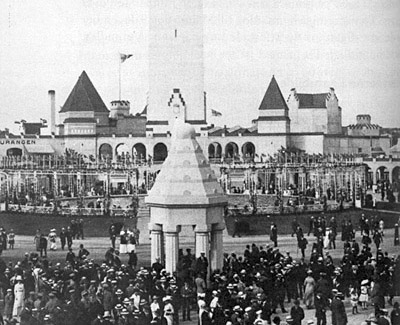| Jugend

| | Baltiske udstilling i Malmø betød bl.a. en præsentation af jugendarkitekturen. Stilartens bannerfører var svenskeren Ferdinand Boberg, der kom til at stå bag flere offentlige svenske bygninger med facader i jugendstil. |
Helsingborg som eksempel
Hvis man vil følge udviklingen fra århundredeskiftets historicistiske forbilleder, via jugend og Art Noveau, til modernismens idealer, er Helsingborg et udmærket eksempel. Helsingborg var, i slutningen af 1800-tallet og begyndelsen af 1900-tallet i rivende udvikling og var derfor i stort behov af nye bygninger. Periodens foretrukne arkitekturstile blev derfor meget rigt repræsenterede i byen.Klassiske stilimitationer forekommer i rimeligt stort omfang.
Ved den øvre del af Stortorvet findes den middelalderinspirerede terrasse og rundt om torvet kan man se mange stilimitationer, f.eks. Skånske Enskilda Bankens bygning fra 1901, som er en barokimitation, og Handelsbanken fra 1904 med antikke islæt.Handelsbanken blev tegnet af byens arkitekt Alfred Hellerström, som også tegnede Helsingborgs Rådhus og Universitetsbiblioteket i Lund, begge i nygotisk monumental stil. Alfred Hellerström blev senere inspireret af jugendstilen, som lige efter århundredeskiftet fik en kort men betydningsfuld blomstringstid, især blandt det velstillede borgerskab.
Lige før 1910 opførtes et helt villakvarter i jugendstil i bydelen Olympia. Foruden Hellerström deltog flere andre arkitekter i projektet, bl.a. Carl Rosenius og Ola Andersson. Husene er kendetegnet af runde tårn og runde hjørner, buede frontoner, vinduer af varierende udseende og mangfoldige ornamenter. Det hele var et tydeligt brud med 1800-tallets stramme byggestile.En mærkelig bygning, fra overgangstiden mellem klassicisme og modernisme, er Krematoriet fra 1929. Bygningen blev tegnet af Ragnar Östberg, mest kendt som arkitekten bag Stockholms Stadshus. Krematoriets kuppel, som indendørs bæres op af klassiske kolonner, har et historicistisk islæt, mens den i øvrigt glatte bygning peger mod stilren modernisme.

Terrassen i Helsingborg | 
Skånes enskilda bank | 
Jugendkvarter i Helsingborg | 
Jugendkvarter i Helsingborg | 
Jugendkvarter i Helsingborg |

Jugendkvarter i Helsingborg | 
Krematoriet i Helsingborg | 
Krematoriet i Helsingborg |
|